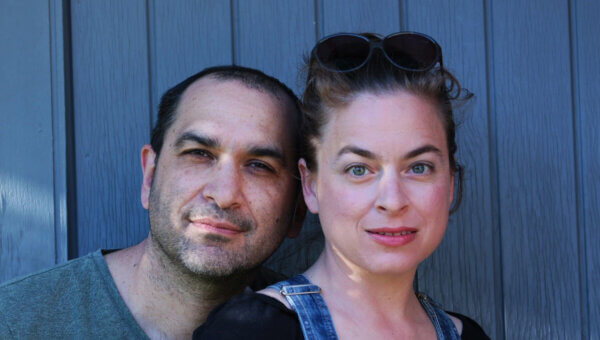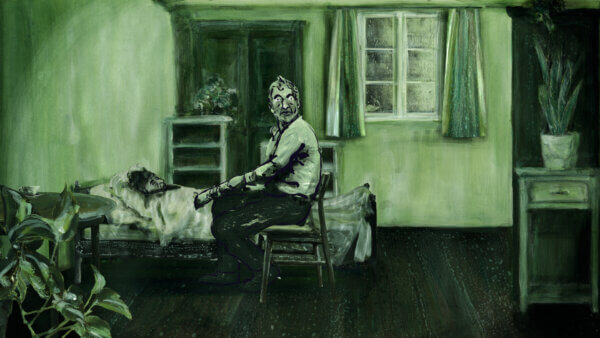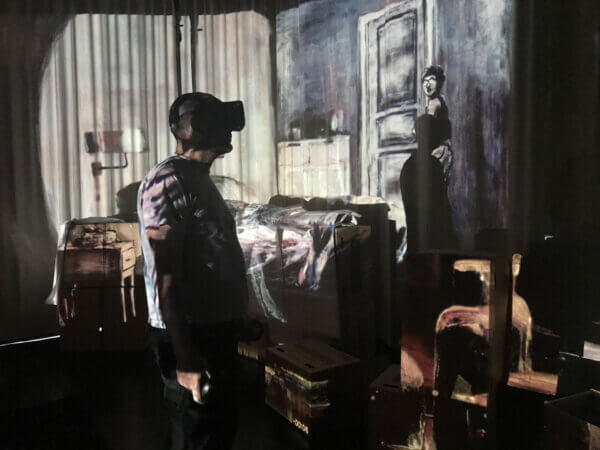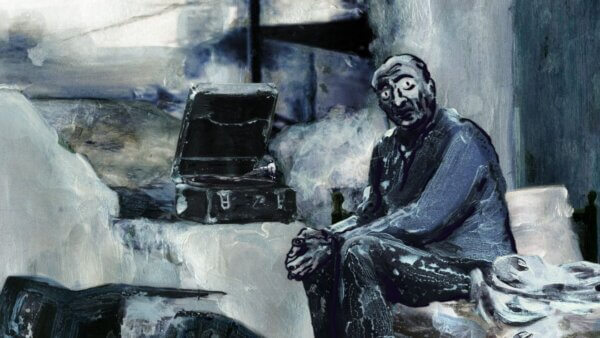Interview with Michelle Kranot (The Hangman at Home | We Are at Home)
Acclaimed artists and filmmakers Michelle and Uri Kranot – whose previous experience with multimedia filmmaking and conceptually progressive storytelling includes the multi-award-winning projects Hollow Land, How Long Not Long, Nothing Happens and Songbird – have again combined their efforts for another thought-provoking and beautifully rendered animation piece. Taking the form of three distinct outputs that will be participating in a variety of festivals this summer, The Hangman At Home exists as a short film (premiering this week at the Krakow Film Festival), a single-user VR experience (part of this month’s Annecy Festival and International Film Festival Rotterdam programmes) as well as a multi-user VR performance and installation We Are At Home that will see its premiere at the Tribeca Film Festival next week.
While each offers their own unique experience, they are conceptually linked by themes of intimacy, complicity, voyeurism and participation as the audience finds themselves alternately looking-in on, interacting with and occupying the personal spaces of a succession of strangers during their private moments. Taking inspiration from the 1922 Carl Sandburg poem of the same name, the scenarios that play out conjure a variety of emotions and personal reflections as regards our own habits, curiosities and social responsibilities as both audience member and participant of the world at large.
The Hangman At Home/We Are At Home is internationally co-produced by Lana Tankosa Nikolic of Late Love Productions in Denmark, Katayoun Dibamehr and Avi Amar of Floréal Films in France, Emmanuel-Alain Raynal and Pierre Baussaron of MIYU Production (France), Marc Bertrand and Julie Roy of The National Film Board of Canada. In anticipation of the busy month ahead for all three outputs we were enthusiastic to catch up with Michelle Kranot about the thematic driving forces behind the project, the processes behind its stunning overall look and her work in supporting similarly ambitious new work as producer and creative director of The Animation Workshop’s creative development platform ANIDOX.
So to begin with, this film took inspiration from the 1922 poem The Hangman At Home by Carl Sandburg – I was interested in what brought it to your attention initially?
In the United States Carl Sandburg is very much part of the canon, he’s really one of the giants of American literature. He won a Pulitzer Prize for his biography of Abraham Lincoln and is really well known, so I feel like I’ve always kind of been aware of Carl Sandburg. Uri had a book of his poems in the drawer for a very long time. Really what brought this particular poem to our attention was, of course, the themes and the feelings it invokes.
The overall concept of the film I really liked, it sort of brings to mind a line from Rear Window, that we can’t possibly explain in public what we do in private. That comes through really well in this film. What would you say bridged the subject of that poem to the concept of the film, of looking in on these people’s private moments?
The poem is the starting point that gives the film its spine. We wanted to explore multiple storylines and intimacies; there’s something about peering into someone’s personal space that is exciting/voyeuristic/“should I be here, should I not?”. The theme of watching and being watched was something that we’d started exploring in other works – for example, in Nothing Happens. For me, The Hangman At Home is a direct continuation of Nothing Happens, where in that film there were these exteriors, these landscapes, watching people outside grouped together, The Hangman At Home watches them in these interior spaces, and your role as spectator is maybe more ambiguous.

Uri and Michelle Kranot (Photo : Adam Kranot)
I was going to ask if it was a companion piece, because I definitely felt like there were certain shared traits. As far as the scenarios we’re watching play out in The Hangman At Home, do any of them have any kind of specific historical or cultural origins, or are they all hypothetical?
Well, they all are quite specific but they don’t necessarily relate to a specific moment in time, or a specific person. They’re all situations that we’ve crafted, with people we know, with objects we feel very close to. Every one of those tableaus is painted in reference to a place and a time and a person who is, for me, quite specific, but I’m hoping that will translate as universal to you, the audience, somehow. I don’t know, what do you think?
Definitely. I mean, certain scenarios are more relatable, I suppose, than others. One I found particularly interesting was the man and the woman in bed, wondering where that’s going and what he’s up to. To me it didn’t quite feel voyeuristic so much as that you were in on something, if that makes sense?
Maybe you are an accomplice?

The Hangman At Home (Late Love Production/Miyu Productions/Floréal Films/NFB)
Almost, yeah, because you don’t participate but you don’t prevent it. I should also say that I’ve only seen the short film version of it, I haven’t experienced the VR version, so perhaps it might be a different feeling.
That was the point. We’re not referring to them as ‘versions’, but rather ‘outputs’, because they are different, though they relate to the same themes. This point that you made about what your role is, that’s precisely what we’re looking at, this question of spectator or accomplice or the fine line between someone who’s a user, someone who’s a participant and someone who’s an audience. That’s precisely why we wanted to explore these different themes of responsibility and accountability in different mediums. You take one medium, which is the actual poem, that’s one thing, and then we have a visual story. The film is very formalistic, it’s edited very precisely, it might seem arbitrary but it is very structured. The VR, you watch every one of these scenes play out, but you choose to walk through that door; literally, you have to choose the door or the fireplace or the window, you make a choice as a user/participant/spectator, we’re playing with all of these different forms of engagement. And in each of the scenes, your role might be a little bit different. In each of the stories, you might take a different point of view.
I remember when we spoke before you were talking about creating an immersive space for Hollow Land, more sort of directly participatory, with masks. Have you always been into the idea of extrapolating multiple experiences from a film idea or a story idea?
Absolutely, and I think that the Hollow Land experience was the first immersive experience that we tried – this was before VR, we’d still put masks on people and kind of limit the way that they can see, we brought a group of people into the room and in some way subjected them to storyline and made them active participants. Maybe that was the first step into VR and immersive storytelling, or VR is just another tool we use for scenography or dramaturgy or new ways of telling stories. I really feel very strongly that it isn’t the technology that is driving the experience but, as we live in times where this is the technology that’s interesting, let’s see what we can do with it. I feel confident that I know how to articulate my thoughts and feelings through film, whereas I still have not as much experience with other ways of storytelling. So it’s quite interesting to see and to talk to people, about how they feel the differences between the mediums have affected them.
So had VR not come along, do you think that The Hangman At Home and Nothing Happens would still have come together in some form?
I think what’s different is that the Hollow Land experience was kind of an offshoot of the film, where we worked together with a theater called Carte Blanche in Viborg – we also continued to work with them for other immersive experiences including Nothing Happens and Songbird and even now we’re working with different people who have been in the Carte Blanche theatre. But Nothing Happens, first and foremost, was a film, then the idea of playing with VR allowed us to deconstruct the film and put it back together in a new way, so the VR in fact came after. The Hangman At Home was always intended as a film, a single user VR, a multi user VR and a performance, it was kind of born as these four things that were being developed at the same time. So it wasn’t something that came after.
As I said, I’ve seen the short film of The Hangman At Home and I initially did the VR of Nothing Happens at Annecy and didn’t see the film version for a little while. Being aware of the other’s existence, in both cases, I came away wondering what the differences might be. When I eventually watched the Nothing Happens short film it did feel like there were elements of added VR that aren’t in the film. I feel like there was a bit in where you’re in a grave or a pit, looking up at the crowd who are looking down at you, is that right?
Yes, in Nothing Happens there are three scenes; and in one, your perspective is in the pit looking up at all these people and then in the other you’re standing in a tree – and the birds are coming at you. In the third you are standing and watching all these people watching something that you don’t see. Whereas in the film, there’s no pit and there’s no tree. There is a tree with birds but you don’t get to stand in it, there are different scenographies than in the film – in The Hangman At Home that’s also the case but, as opposed to Nothing Happens, it’s actually an interactive piece. So in the film of The Hangman At Home you get to watch these stories chopped up together, where the gesture is the key, the movement of the different characters in the story, that’s what you’re trying to unlock. And in the VR, the stories play out depending on which room you walk into, you don’t necessarily get to see all of the stories. And there are entire rooms where you get to experience things and move things and make things happen. You also get to create a whole soundscape, which of course you don’t do in the screen-based Hangman At Home. Then in the multi user experience, you get to do all that with four other people. In the performance, there is also an added layer of dramaturgy, with a performer and projections, for a larger audience.
So the multi user version, is that We Are At Home?
Yes, because it’s an installation and performance we felt that we would wrap it differently, so it even has a different title. The film is premiering at the Krakow Film Festival, almost at the same time as We Are At Home, which is premiering at Tribeca. So it’s all kind of happening at the same time, but they are very different from each other. What I’m hoping is going to happen is that we get to discuss and question how a VR multi user experience is different than single user, and how is the screen based experience different from the immersive experience? If you’re watching it in a cinema and you really feel that surround sound, with all the other people in the room with you, does that affect the way that you feel, and what you know about your role or your responsibility? How do you address the themes of the piece? – as opposed to if you’re watching it at home on your laptop? Is trying the single user VR at a festival or even downloaded at home, is that very different than trying it with a whole scenography? How does having a shared experience versus a solitary one affect your perception of the themes that we deal with? The different stories unfold in different ways; every one of the five stories we tell has kind of a different setup but I think in every one of them we ask this question of “what is my responsibility here? If I’m just going about my day and doing all my daily things, and we’re just hanging out at home, do I need to take a look at the world outside?”. Then you can take a step back and look at a broader or bigger political question – and it is quite fiercely political.

We Are At Home (Late Love Production/Miyu Productions/Floréal Films/NFB)
The Hangman at Home has certain shared visual qualities to Nothing Happens, would you say the overall process as far as capturing and translating the movement to that sort of painterly animation environment is the same, or has it been adapted at all?
We added a line of animation on top of the painting to try to bring out a caricature aspect. So the video was shot with actors wearing masks, covering their eyes and nose, and then we edited and manipulated the frame rate. So there was an initial layer of manipulation, then there was Photoshop, then we printed it and painted frame by frame over the characters, then digitised that. Later the contour line was animated on top of the painted animation. The idea behind that was to really focus on the gestures. They’re quite subtle gestures in the way that the characters interact with each other, their movement is really important and we thought that having the additional layer of line animation could really highlight those very subtle gestures and movements, which can hold the story, I think.
I think also the slight softening of the eyes, from Nothing Happens to this, just adding whites to their eyes…
Yeah, or facial expressions.
Yeah, the eyes are so chilling in Nothing Happens because it’s these pinpricks just focused on you. Out of curiosity did that come from anywhere in particular?
I can’t say, I guess it’s something that just felt right. I mean, it was about staring you down. I don’t really feel that you can identify with an animated character. You know, we tell people it’s all in the eyes and I don’t really think that any of that’s true. I think that you can’t create this kind of feeling of emotional connectedness and emotional connection through animated characters. This was kind of a point we were trying to make, I think, to kind of take it as far away as possible from those big googly eyes that are supposed to try to force you to feel something, trying to force you to feel anything. Maybe that does make it a little bit cold and intellectual somehow, but I think that by bringing it back to painting and more into the realm of the fine arts we can look at this more as a moving painting than a conventional animated film.

The Hangman At Home (Late Love Production/Miyu Productions/Floréal Films/NFB)
Like you say, you don’t necessarily relate to a character if they have expressive eyes, but the absence of expression can really get you somewhere in your brain. With The Hangman At Home it’s almost more effective because for so long you’re the one observing them, then suddenly they’re staring at you. It’s very effective, throwing that at the audience.
I think that it is a tool but it’s not a gimmick, I believe that this is precisely what the poem does, it really brings it home, it talks about home, it talks about some other character you could be, but then as soon as you realise that you could be the hangman that’s when you ask “Wait a minute, how am I contributing to this?” I think that goes back to what was so attractive about the poem to begin with, is that it has a playfulness to it, something mundane, then that last line at the end – “anything is easy for a hangman”. “Oh, sure. I’m just gonna go make myself another cup of coffee and not think about where it comes from, and what the implications of that are”.
Yeah, and more and more nowadays we’re given insights into what the cost of everything is, and you sort of have this moral choice to say “Okay, I’ll just not acknowledge that, I’ll just carry on.”
Precisely, you are making a moral decision. You’re making a choice; it doesn’t feel like one, though. The Hangman At Home is not pointing fingers, it’s really not about blaming anybody, it’s just this question of “What do I think about this? How does this feel right now?” It doesn’t look at anybody and say “You should be doing something about this” or “You should be doing something different”. It’s really not. It’s more like a question – “Should we? Are we?” And I think that We Are At Home brings that even closer somehow. But I don’t know because I haven’t talked to many people who’ve tried it yet, but I do look forward to talking to people who’ve seen the film.
The film version you mentioned is going to premiere at Krakow, then We Are At Home at Tribeca and I think quite shortly after the VR is going to be at Annecy?
It’s at Annecy and also Rotterdam Film Festival, then there are lots more festivals. It’s great, it’s going to a lot of places but I don’t know if I get to go with it. One of the reasons I became an animator in the first place – although I don’t label myself an animator anymore – is because of animation festivals. I love animation festivals, I just wonder when I get to go again, and what would that be like? So the film and the VR are doing well and I kind of wish that I could accompany it and talk to some of the people who’ve tried it and seen it so that I could learn something. But I guess this is a start, this conversation is nice. It makes me feel that there are these interesting conversations to be had.
Last time we spoke a bit about your work with ANIDOX, it would be great to remind readers about what that is and the types of projects you do.
We’re in our ninth year now of the ANIDOX Lab, which is a professional training programme at The Animation Workshop, but ANIDOX as a whole is an umbrella for all of these different activities where one of them is the Lab. The Lab is for animated documentary projects that are in development. We had a residency programme as well, so we’ve supported a number of really interesting films and now the focus of the residency is more towards ANIDOX VR. There’s an open call now for the ANIDOX VR Awards Exhibition, an exhibition of animated documentaries in virtual reality which is part of the Viborg Animation Festival. There’s a prize but also a residency award for the development of new work, which I find really exciting because I like the figuring-out-what-it-wants-to-be stage, so we get to support other filmmakers in that process. It’s very much about bridging between documentary practice and animation practice, so I’d say the target for the ANIDOX programme is either those with an animation background who are very curious about the truth-telling aspect of documentary filmmaking, but we also very much target filmmakers, sometimes even quite established documentary filmmakers who are making their first animation.
So that’s kind of the bridge, and the network we are building – and we’ve had a lot of quite successful projects so far. They do take a long time to get realised. Like Flee for example, a Danish/French feature film that’s doing the rounds now and is really successful, by Jonas Poher Rasmussen; he started his journey with us at ANIDOX. And there are examples like Just A Guy by Shoko Hara and Egg by Martina Scarpelli, who was part of the ANIDOX programme from the very beginning and works very closely with us now; mentoring and working with our lab participants. ANIDOX has become more than just a professional training programme or showcase for VR, but it really is a community. When it comes to navigating online festivals you might not have a big distribution company or production company behind you, so ANIDOX sometimes fills in some of those gaps. We also do matchmaking between the filmmakers and artists, as well as masterclasses and workshops at different venues and offer expertise through training programmes, which goes hand in hand with our personal practice. I’m curious about VR now – and we’ve been curious about animated documentary since we started making films – so we invite people who we feel that we could all learn from. It’s really this kind of peer-based learning scheme and it’s interesting to see how that network also feeds into the personal projects that we do.
ANIDOX:VR Awards Open call: https://anidox.com/events/anidoxvr/
ANIDOX:VR Awards Exhibition & Seminar is a part of Viborg Animation Festival held 21.09.21 – 03.10.21. With kind support from The Animation Workshop / VIA University College, Vision Denmark, Viborg Kommune, The Danish Film Institute, The ministry of Higher education and Science. Sponsored by Gallery NB and HTC VIVE.
See more works by Michelle and Uri Kranot at tindrum.dk


